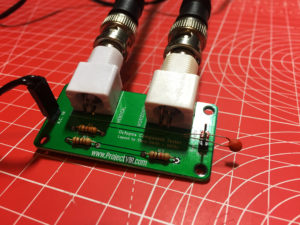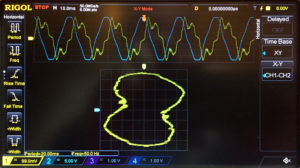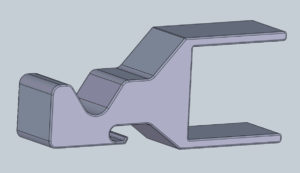In the last post, I wrote that the Octopus Component Tracer boards had arrived. I have since built one up and tried it out with my Rigol 1054Z (Hacked).
Here shown with a small capacitor under test. This is supposed to produce an elliptical test pattern. I got rather different results, and after a lot of mucking around with settings.
As you can see, one of the waveforms is distorted. I think this is why the lissajous figure is not very regular. I took an old 6V AC to DC wallwart and modified it for AC output. Obviously, not the nicest of outputs. I retried with my signal generator producing a 5V Peak to Peak Sine wave but got pretty much the same results.
I suspect that the components on the Octopus aren’t quite optimal. I will do some more research and see if I can get better traces. I have also decided that if I update the board, I will space the BNC connectors the same distance apart as my oscilloscope, meaning I can use barrel connectors to mount the board, rather than use lossy cables. Stay tuned for updates.
I completed the Anet A8 3D Printer build shortly before the Octopus and it all seems to fire up and work correctly. I have filament and painters tape on order, so I will have to wait to do my first ever 3D Print. Although the printer comes with several example files to print, I have already designed a Headphone Hanger Clip with an old version of Solidworks.
The right hand side of the device clips on to a shelf I have over my workbench. The headphones should fit nicely on the upper hook and the cable can be coiled and hung undeneath on the smaller hook. I’m looking forward to seeing how it prints.



